
|

|
|
Project
Summary: Cabrini First Hill Apartments
OWNER/DEVELOPER
The Missionary Sisters of the Sacred Heart of Jesus/ Low Income Housing
Institute
ARCHITECT
GGLO
LANDSCAPE ARCHITECT
GGLO
CONTRACTORS
Walsh Construction Company
PROPERTY MANAGEMENT
Low Income Housing Institute
|
FUNDERS:
|
TYPE:
|
|
Bank of America
|
Loan
|
|
Enterprise Community Investment, Inc.
|
Tax Credit Investment Grant
|
| Federal Home Loan Bank of Seattle |
Loan |
|
King County Harborview Replacement Funds
|
Grant
|
|
State of Washington Dept. of Community Trade and Economic Development
|
Grant
|
|
US Dept. of Housing and Urban Development
|
HUD 202 Grant
|
|
Washington Community Reinvestment Association
|
Grant
|
|
Washington State Housing Finance Commission
|
Grant
|
|
Washington Mutual Affordable Housing Fund Limited Partnership
|
Grant
|
DEVELOPMENT
TYPE
50 units of low income, senior apartments in mixed used building.
Six stories containing five levels of apartments over ground level
retail space. Project also contains one level of below grade
accessory parking.
RESIDENT PROFILE :
Tenant incomes range from 30, 50, or 60% of area median income,
with ten units set aside for formerly homeless seniors.
DENSITY: 161 units per acre
DEVELOPMENT
PROFILE
|
Type
|
#/Units
|
Size
(sf)
|
Rent
|
| 1 BR |
49 |
505 avg |
$500 avg |
| 2 BR |
1 |
743 |
$526 |
| Total |
50
|
|
|
Community facilities: Community Room with Kitchen,
Courtyard, Computer Room, Quiet Room/ Library,
Sunroom and View Terrace, Community Services Offices,
Residential Lobby, and Common Laundry Facilities
Parking: 33 stalls
Total site area:
13,471 sf
|
CONSTRUCTION
TYPE
One story, plus basement of concrete, type 1A construction
below five stories of wood frame, type VA construction.
DEVELOPMENT
COSTS
Land cost: $0; Constr. costs:
$8,494,480; Other costs: $0; Total
development costs: $8,494,480 ;
Completed February, 2006
|
|
|
Cabrini Apartments -
Seattle, WA
Green Features
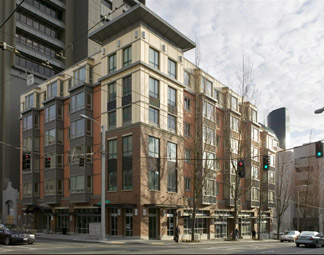
Cabrini First Hill Apartments provides independent living for low-income seniors in
Seattle, Washington. Located in a commercial district, the building is on the corner
of a compact 1/4 block urban infill site the current owners have had since the early
19th century.
On a street mixed with historic structures and contemporary buildings, Cabrini
provides pedestrian level interest ground level retail space with five levels of
apartments are above. The apartments are efficiently sized with high ceilings and
large windows. Large common areas such as the building lobby, community room, and an
upper level courtyard promote social interaction among the residents of the building.
Major bus lines are available outside the front door, car parking is available
underground, and bicycle parking is provided within the building.
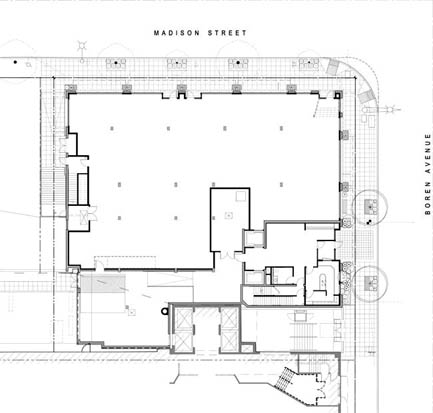
Cabrini Apartments is built to the criteria of the Seattle City Light BuiltSmart
program and designed to meet the Master Builders Association BuiltGreen 3-Star sustainable
design program level. Promoting energy efficiency and the management of resources, the
sustainable strategies were developed at an early stage with the owners, the public, and
a multi-disciplinary team of professionals.
Energy efficiency was achieved with a well-insulated building envelope
and vinyl-framed double-glazed low E windows. Also, to provide tenant comfort
throughtout the year, the windows are operable.
The management of water, constuction material and waste required thoughtful planning.
The Seattle environment accommodated a wide selection of drought resistant and shade
tolerant planting for the landscaped courtyard. Water was further conserved with high
efficiency drip irrigation for all the landscaping.
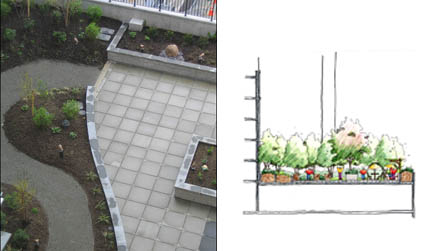
The Seattle setting also enabled the builders to use locally available brick, concrete,
and wood framing. Selection of other building materials focused on those with recycled
content including the concrete, carpet padding, engineered lumber, and metal framing.
Construction waste was recycled with approximately 90% of waste materials diverted from
landfills.
To safeguard indoor air quality, exterior moisture protection was
addressed through careful rainscreen and air barrier detailing and inspection of those
details by professional consultants during construction. Other measures included the use
of low VOC materials and continuously running whole house
exhaust fans.
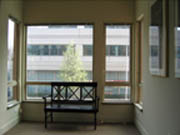
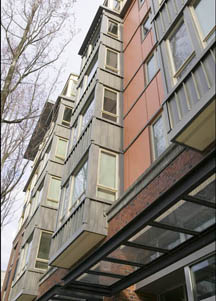
Lessons Learned from the architect -
-
Providing common areas for residents such as the landscaped courtyard extends
the living area to the outdoors. This area with its natural daylighting and water
conserving plantings also filters the air and efficiently moderates the temperature.
As a living space with many attributes, the outdoor courtyard serves as a model of
efficiency for the interior spaces to emulate.
-
Maximum apartment unit size limits from the funding providers required that the
units be compact and efficient. In order to make the units still be inviting and
open, tall ceilings and large bay windows are used to provide natural lighting and
the feeling of more space within the units.
-
Since the units are relatively small, we increased our focus on providing usable
communal gathering spaces. From the community room and adjacent outdoor courtyard,
to the upper level sunroom and terrace, to the spacious lobby, providing spaces
where people can congregate was a priority.
-
The sustainable design strategies focused on items that will directly affect the
tenants. As the people living there will be in the lowest income ranges, some formerly
homeless, we concentrated on elements that will directly affect both their utility
bills and their personal comfort. Energy savings with a compact well-insulated building
envelope, water savings with low flow fixtures, and healthy indoor air with low VOC
paints and carpets were the main goals of sustainability.
-
Budgeting challenges due to unanticipated below grade excavation and a booming construction
market in Seattle forced tough choices about project cost. A rooftop garden space and
hydronic heating system were sacrificed and fiber cement panels were substituted for a
stucco exterior. Despite these changes, the building is still refined, elegant, and provides
wonderful indoor and outdoor spaces for the tenants.
|




